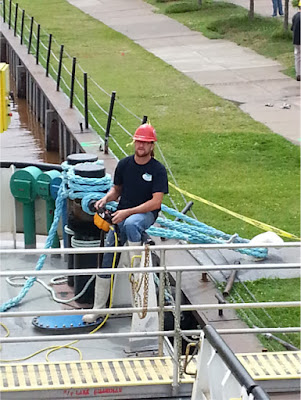
A Watershed Educator’s Shipboard Experience, Part 2 – The Ship
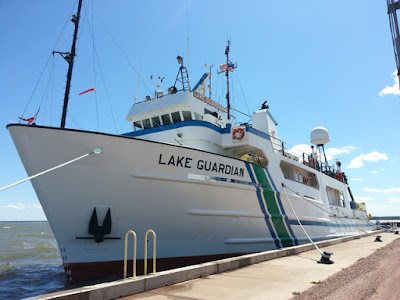 |
| The Lake Guardian |
In Part Two I will focus on the ship itself and the experience of being aboard the ship (research facilities, living quarters, food, crew, pilot house, amenities, etc.). Come along for the tour!
The Lake Guardian is 180 feet long (the length of four school buses placed end-to-end) and sleeps 42 people in its hotel deck. Constructed in 1981 to serve as a supply vessel for offshore oil rigs in the Gulf of Mexico, the ship was purchased in 1990 by the EPA and converted into a research vessel.
 |
| Jacob Petersen, a teacher from Eau Claire, Wisconsin, and a crew member watch as preparations are made to leave port. |
The ship’s homeport is in Milwaukee, Wisconsin. When it returns to Milwaukee to refuel, the process can take an entire day as it can hold up to 79,000 gallons of fuel – that’s six-tanker trucks worth of fuel! The Lake Guardian has two engines, each with 1200 horsepower, and has a cruising speed of 10.8 knots. That is equivalent to 12.4 miles per hour on land.
 |
| Layout of the main deck. Notice the labs! |
The Lake Guardian is the EPA’s largest research and monitoring vessel, sailing between late March and early October among all five Great Lakes (Superior, Michigan, Huron, Erie and Ontario) and their connecting channels. Researchers from government agencies and universities use the ship’s facilities to collect and analyze samples of water, aquatic life, sediments and air. The US EPA Great Lakes National Program Office (GLNPO) manages the ship’s operations from their Chicago-based office.
 |
| The Lake Guardian in port, from the stern. |
Crew
|
|
The Lake Guardian has a permanent crew of up to fifteen people (the number of additional passengers varies by cruise, depending on how many EPA and visiting scientists are involved with a particular project). The crew and scientists work round-the-clock, adhering to a six-hours-on, twelve-hours-off schedule.
Bridge
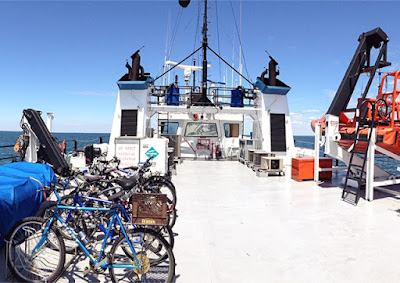 |
| The Bridge |
The Bridge is the top deck on the ship where the rescue boats, pilot house and rosette-operating booth are located. The Bridge also provides parking space for crew members’ bikes which are useful for getting out and exploring port cities during land side off-duty hours.
 |
| Life saving equipment on the Bridge |
 |
| The Bridge is the best place to be when arriving or leaving port. Here we are preparing to leave Duluth. |
Pilot House
 |
| Looking through the door leading to the Pilot House from the Main Deck |
The Pilot House is where the captain and mates operate the ship’s navigational equipment.
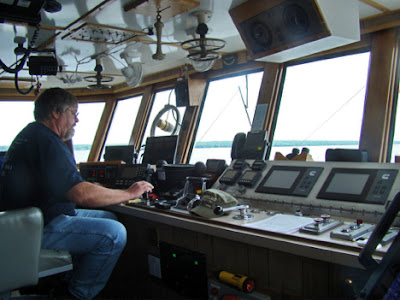 |
| Captain John Mallard at the controls in the Pilot House |
 |
| A chart in the Pilot House |
Aft Deck
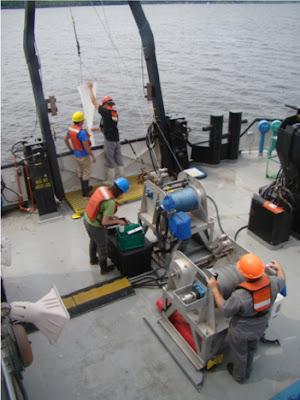 |
| Looking down from the Main Deck to the Aft Deck during a sampling stop |
The Aft Deck is the platform at the back of the ship from which various scientific tools are deployed. Life vests, hard hats and steel toed boots must be worn by anyone on the Aft Deck. There are several winches, including a large hydraulic “A-frame” winch, located at the stern. This winch has a maximum capacity of 30,000 pounds. This is the equipment from which the benthic sled, multi-corer, bow corer, etc. are deployed.
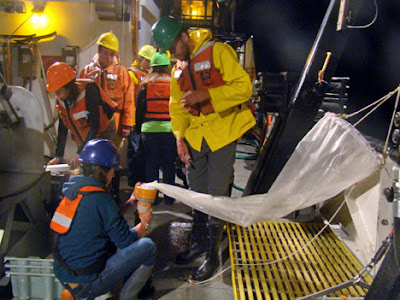 |
| Collecting zooplankton samples at night from the Aft Deck |
A smaller winch is used to deploy the PONAR and the zooplankton nets from the starboard side of the aft deck. If the captain needs to use the engine during a sampling session, he is careful to only employ the engine on the opposite side of the ship from where the sampling is taking place to reduce effects on the samples collected.
Rosette Operating Deck
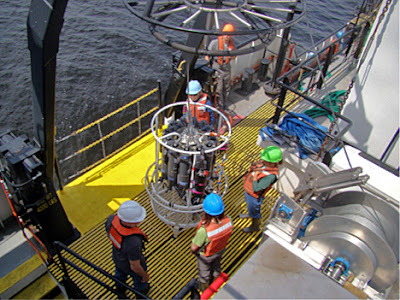 |
| Looking down on the Rosette Operating Deck from the Bridge |
 |
| Looking toward the Rosette Operating Deck from above the Aft Deck. The Rosette Operating Booth can be seen above the deck. |
The Rosette Operating Deck is the working deck where the Rosette is stored and from which it is deployed.
 |
| Several people are required to guide this expensive water quality monitoring equipment as the winch and crane lift it off of and back onto the deck. |
Rosette Operating Booth
 |
| The Rosette Operating Booth is a tiny room on the bridge from which a crew member operates the Rosette. |
Depths of interest for collections tend to be the surface waters (the epilimnion), the frigid depths (the hypolimnion) and the transition between the two called the thermocline (as well as where the transitions occur between these three layers). The thermocline shifts within each lake at various times during the year. These shifts are of particular interest to scientists.
Biology Lab
The Biology Lab is generally used to study phytoplankton, zooplankton and benthos (bottom dwelling organisms). The bio lab contains a fume hood, canopy hood, deionized water system, vacuum, refrigerator, freezer, phone, eyewash, incubator and a high efficiency particulate air filter.
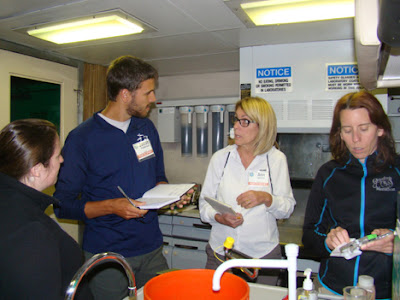 |
| Educators and scientists process samples and record zooplankton data in the Bio Lab. |
Chemistry Lab
The Chemistry Lab is where the diporeia research took place on our cruise. However, it is most often used for contaminant extractions from various media. The Chem Lab contains two fume hoods, a canopy hood, deionized water system, vacuum, refrigerator, incubator, phone, eyewash and three high efficiency particulate air (HEPA) filters.
 |
| The Chemistry Lab |
Wet Lab
The Wet Lab contains an array of safety and laboratory equipment including life preservers, hard hats, steel toe boots and rain pants, as well as computers, work benches, a fume hood and a sink and eye wash. As educators, we spent much of our time in the Wet Lab working on reports, participating in lessons and listening to presentations by professors from local universities who came aboard the ship while we were in port.
 |
| Educators working on the Shrinking Cup activity in the Wet Lab |
 |
| This area of the Wet Lab, also known as Dr. Glenn Warren’s hang out, is where samples collected from the Rosette are analyzed for various water quality parameters. |
Hotel Deck
 |
| Shhhh! Quiet rules here. There are often people sleeping in their dormitories at every time of day. |
The ship’s passengers are divided among the sixteen cabins on board that come furnished with a bunk bed, desk, locker space and access to either a private or shared bathroom. Round-the-clock work schedules make it important to keep noise to a minimum at all times while on the hotel deck to respect individuals who may be sleeping when off-duty.
I shared a cabin with two other women, and our cabin connected to another three-person cabin through a shared bathroom in between. Bunks were surprisingly comfortable and the purring of the engine provided great white noise for lulling us to sleep, although not everyone appreciated this.
Galley
A full-time galley staff prepares meals each day. There are many delicious and healthy choices offered at every meal.
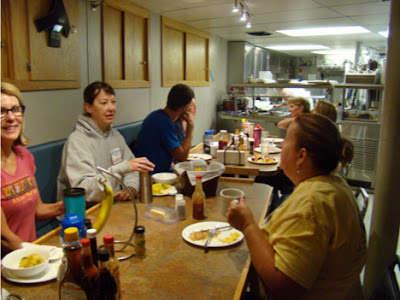 |
| Everyone’s favorite place on the ship! Officers, crew and scientific personnel all eat together at set meal times. |
Workout Room
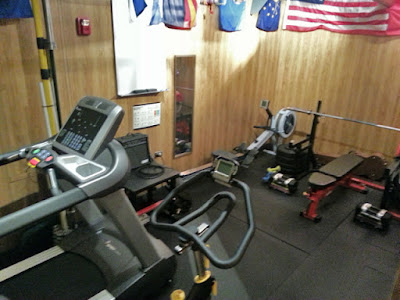 |
| Looking down the steps to the Workout Room |
The Workout Room is accessible from the main deck, a place to unwind and get some exercise! Some crew members use their musical equipment here too.
Lounge
A place for crew and scientists to relax when off-duty, furnished with a table and chairs, couches, a stereo, satellite TV and DVD player. Don’t tell anyone, but there are also lots of treats and chocolates in the cupboards.
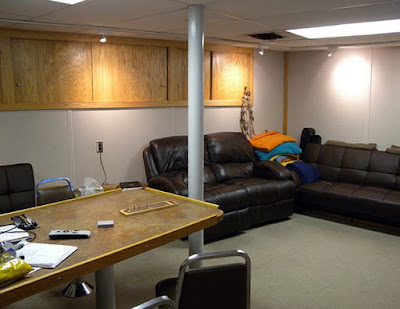 |
| Everyone must be working! |
Spending a week aboard the Lake Guardian was an unforgettable experience. We pulled sediment from over 300 meters down in one of the deepest sites in Lake Superior, we hypothesized how much our Styrofoam cups would shrink when submerged at depth with the Rosette, we survived a storm, our eyes got a workout counting zooplankton and most of the time we remembered to be quiet on the hotel deck.
 |
| The computer in the Wet Lab tracking the Guardian’s course shows the ship in the vicinity of the Apostle Islands. |
 |
| We were treated to a beautiful sunset over Madeline Island. |
The research was fascinating, the food was delicious, the crew, scientists and educators were wonderful and Lake Superior was beautiful. Kudos to the Center for Great Lake Literacy and their partners for creating such an outstanding program!
Captain John is a seasoned and capable pilot, as well as a very likable and amiable guy.
THANK YOU, Captain John!

